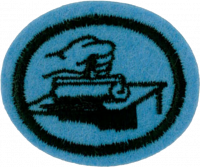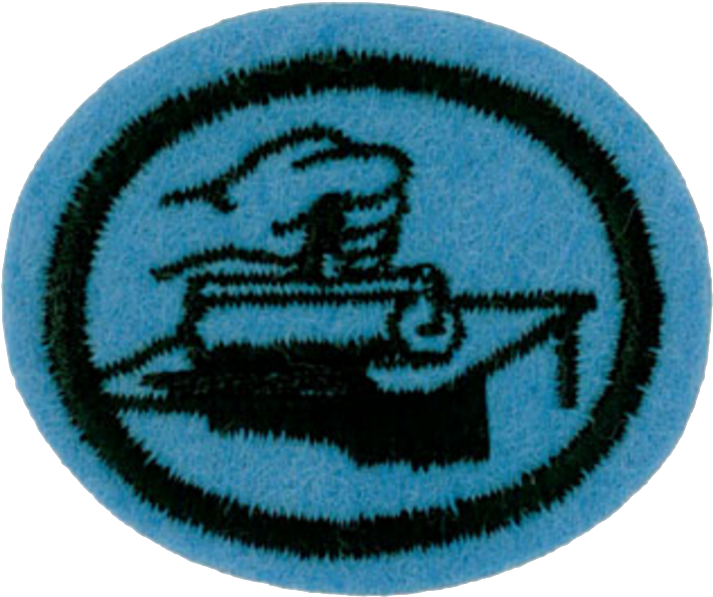|
|
| (3 intermediate revisions by the same user not shown) |
| Line 2: |
Line 2: |
| | <section begin="Body" /> | | <section begin="Body" /> |
| | {{ansreq|page={{#titleparts:{{PAGENAME}}|2|1}}|num=1}} | | {{ansreq|page={{#titleparts:{{PAGENAME}}|2|1}}|num=1}} |
| − | <noinclude><div lang="en" dir="ltr" class="mw-content-ltr"> | + | <noinclude></noinclude><!-- instance 1 --> |
| − | </noinclude><!-- instance 1 --> | + | <!-- 1. Hacer una lista de las herramientas y equipos necesarios para la impresión. --> |
| − | <!-- 1. List the tools and equipment necessary for block printing. --> | |
| − | [[Image:Intaglio-rollers.JPG|thumb|200px|A variety of brayers]]
| |
| − | ;Block: The ''block'' is a piece of material into which the design to be printed is carved. Linoleum is a common block material, but people also use wood, or even potatoes. Linoleum is inexpensive, easy to carve, and makes good prints. Wood is more difficult to work with, and potatoes do not make the greatest prints. Also, you can't really save a potato, as it will begin to decompose as soon as it is cut. Linoleum can be put away for several years and then reused. A [http://www.youtube.com/watch?v=HQhntptX_dE new technique] uses hobby foam sheets glued to Styrofoam or some other base, which allows you to carve the image without reversing it. Another easy to work with block material is lightweight foam (perhaps from recycled fast food take out containers) as used in [http://www.youtube.com/watch?v=3VeRZ5UAwFo this video].
| |
| − | ;Sandpaper: If you are using linoleum or wood, you will need to sand the surface first to eliminate the texturing. Texturing will come through in your print, which may or may not be desired.
| |
| − | ;Ink or Paint: Many people prefer to use oil-based ink, but beware - oil-based inks will permanently stain clothing. If you are teaching this honor to a group of children, you would be well advised to stick with water soluble ink. For different effects you can use water soluable paints.
| |
| − | ;Brayer: A brayer is a hand roller used in printmaking techniques to spread ink or to offset an image from a plate to paper. They can be made of rubber, sponge, acrylic, or leather. Rubber brayers come in varieties of hardness and are primarily used for relief printing. Leather rollers are only used in lithography. Sponge rollers are used only for scrapbooking and other craft applications. A spoon can stand in for the brayer.
| |
| − | ;Piece of Glass: Ink is poured onto a piece of glass, and then the brayer is rolled over it. This transfers the ink to the brayer. An old picture frame can work well for this.
| |
| − | ;Paper or fabric: Your design must be printed on ''something'', right?
| |
| − | ;Baren: The baren is a disk like device with a flat bottom and on the reverse side, a knotted handle. The baren is used to burnish (firmly rub) the paper to pick up ink that has been rolled onto a wood. linoleum, or hobby foam cut. You can also use a wooden spoon, soup spoon or even a rolling pin for this.
| |
| − | ;Carbon paper: Optional item for transferring traced images to the linoleum
| |
| − | ;Paper towels: For cleaning up!
| |
| − | </div>
| |
| | | | |
| − | <div lang="en" dir="ltr" class="mw-content-ltr">
| + | <noinclude></noinclude> |
| − | <noinclude> | |
| − | </div></noinclude>
| |
| | {{CloseReq}} <!-- 1 --> | | {{CloseReq}} <!-- 1 --> |
| | {{ansreq|page={{#titleparts:{{PAGENAME}}|2|1}}|num=2}} | | {{ansreq|page={{#titleparts:{{PAGENAME}}|2|1}}|num=2}} |
| − | <noinclude><div lang="en" dir="ltr" class="mw-content-ltr"> | + | <noinclude></noinclude><!-- instance 1 --> |
| − | </noinclude><!-- instance 1 --> | + | <!-- 2. Escribir un párrafo sobre los principios de diseño y letras tal como se aplica para la impresión xilográfica. --> |
| − | <!-- 2. Write a paragraph on the principles of design and lettering as applied to block printing. --> | |
| − | The most confusing aspect of block printing letters is that the letters must be carved into the block as a mirror-image. When the block is pressed to the paper, the image will be reversed, and the letter will look proper. The saying ''"watch your p's and q's"'' comes from the fact that a ''p'' looks like a ''q'', and a ''q'' looks like a ''p'' when viewing the type (whether movable type, or letters carved into a block).
| |
| − | </div>
| |
| | | | |
| − | <div class="mw-translate-fuzzy">
| |
| | {{clear}} | | {{clear}} |
| − | </div>
| |
| | | | |
| − | <div class="mw-translate-fuzzy">
| |
| | {{clear}} | | {{clear}} |
| − | </div>
| |
| | | | |
| − | <div class="mw-translate-fuzzy">
| |
| | {{clear}} | | {{clear}} |
| − | </div>
| |
| | | | |
| − | <div lang="en" dir="ltr" class="mw-content-ltr">
| + | <noinclude></noinclude> |
| − | <noinclude> | |
| − | </div></noinclude>
| |
| | {{CloseReq}} <!-- 2 --> | | {{CloseReq}} <!-- 2 --> |
| | {{ansreq|page={{#titleparts:{{PAGENAME}}|2|1}}|num=3}} | | {{ansreq|page={{#titleparts:{{PAGENAME}}|2|1}}|num=3}} |
| − | <noinclude><div lang="en" dir="ltr" class="mw-content-ltr"> | + | <noinclude></noinclude><!-- instance 1 --> |
| − | </noinclude><!-- instance 1 --> | + | <!-- 3. Usando una papa, crear un diseño que incorpore sus iniciales y utilícelo para imprimir sus iniciales en papel. --> |
| − | <!-- 3. Using a potato, carve a design incorporating your initials into it, and use it to print your initials on paper. --> | |
| − | Remember to reverse the letters and to put your first initial on the ''right'' side of the potato, and your last initial on the ''left''.
| |
| − | </div>
| |
| | | | |
| − | <div class="mw-translate-fuzzy">
| |
| | {{clear}} | | {{clear}} |
| − | </div>
| |
| | | | |
| − | <div class="mw-translate-fuzzy">
| |
| | {{clear}} | | {{clear}} |
| − | </div>
| |
| | | | |
| − | <div class="mw-translate-fuzzy">
| |
| | {{clear}} | | {{clear}} |
| − | </div>
| |
| | | | |
| − | <div lang="en" dir="ltr" class="mw-content-ltr">
| + | <noinclude></noinclude> |
| − | <noinclude> | |
| − | </div></noinclude>
| |
| | {{CloseReq}} <!-- 3 --> | | {{CloseReq}} <!-- 3 --> |
| | {{ansreq|page={{#titleparts:{{PAGENAME}}|2|1}}|num=4}} | | {{ansreq|page={{#titleparts:{{PAGENAME}}|2|1}}|num=4}} |
| − | <noinclude><div lang="en" dir="ltr" class="mw-content-ltr"> | + | <noinclude></noinclude><!-- instance 1 --> |
| − | </noinclude><!-- instance 1 --> | + | <!-- 4. Diseñar e imprimir al menos una tarjeta de felicitación. --> |
| − | <!-- 4. Design and print at least one greeting card. --> | |
| − | For this, we highly recommend that you use linoleum for the printing block. As you should well know from your experience with the previous requirement, potato printing leaves a lot to be desired.
| |
| − | </div>
| |
| | | | |
| − | <div class="mw-translate-fuzzy">
| |
| | {{clear}} | | {{clear}} |
| − | </div>
| |
| | | | |
| − | <div class="mw-translate-fuzzy">
| |
| | {{clear}} | | {{clear}} |
| − | </div>
| |
| | | | |
| − | <div lang="en" dir="ltr" class="mw-content-ltr">
| + | <noinclude></noinclude> |
| − | <noinclude> | |
| − | </div></noinclude>
| |
| | {{CloseReq}} <!-- 4 --> | | {{CloseReq}} <!-- 4 --> |
| | {{ansreq|page={{#titleparts:{{PAGENAME}}|2|1}}|num=5}} | | {{ansreq|page={{#titleparts:{{PAGENAME}}|2|1}}|num=5}} |
| − | <noinclude><div lang="en" dir="ltr" class="mw-content-ltr"> | + | <noinclude></noinclude><!-- instance 1 --> |
| − | </noinclude><!-- instance 1 --> | + | <!-- 5. Diseñar e imprimir una etiqueta o una portada de un libro. --> |
| − | <!-- 5. Design and print one bookplate or book cover. --> | |
| − | Follow the procedure outlined in the previous requirement. A bookplate is a small piece of paper that is glued to the inside cover of a book to identify the owner. This obviously will require you to print some text, as that's the only way most of us write our names. A book cover should have the book's title as well as the author's name. It should be large enough to cover the outside of the book.
| |
| − | </div>
| |
| | | | |
| − | <div lang="en" dir="ltr" class="mw-content-ltr">
| + | <noinclude></noinclude> |
| − | <noinclude> | |
| − | </div></noinclude>
| |
| | {{CloseReq}} <!-- 5 --> | | {{CloseReq}} <!-- 5 --> |
| | {{ansreq|page={{#titleparts:{{PAGENAME}}|2|1}}|num=6}} | | {{ansreq|page={{#titleparts:{{PAGENAME}}|2|1}}|num=6}} |
| − | <noinclude><div lang="en" dir="ltr" class="mw-content-ltr"> | + | <noinclude></noinclude><!-- instance 1 --> |
| − | </noinclude><!-- instance 1 --> | + | <!-- 6. Pasando por las etapas de diseño, tallado o impresión, crear otra pieza original de trabajo de su elección. --> |
| − | <!-- 6. Going through the steps of designing, carving, and printing, create another original piece of work of your choice. --> | |
| − | This could be a poster, another greeting card, another bookplate, another book cover, or whatever you would like to make. Repeating a carved pattern, while rotating it and/or changing the color can can create art work worth framing.
| |
| − | </div>
| |
| | | | |
| | {{clear}} | | {{clear}} |
| | | | |
| − | <div lang="en" dir="ltr" class="mw-content-ltr">
| + | <noinclude></noinclude> |
| − | <noinclude> | |
| − | </div></noinclude>
| |
| | {{CloseReq}} <!-- 6 --> | | {{CloseReq}} <!-- 6 --> |
| − | <noinclude><div class="mw-translate-fuzzy"> | + | <noinclude></noinclude> |
| | ==Referencias== | | ==Referencias== |
| − | [[Category:Adventist Youth Honors Answer Book/es]]
| + | <noinclude></noinclude> |
| − | <noinclude> | |
| − | </div></noinclude>
| |
| | {{CloseHonorPage}} | | {{CloseHonorPage}} |


